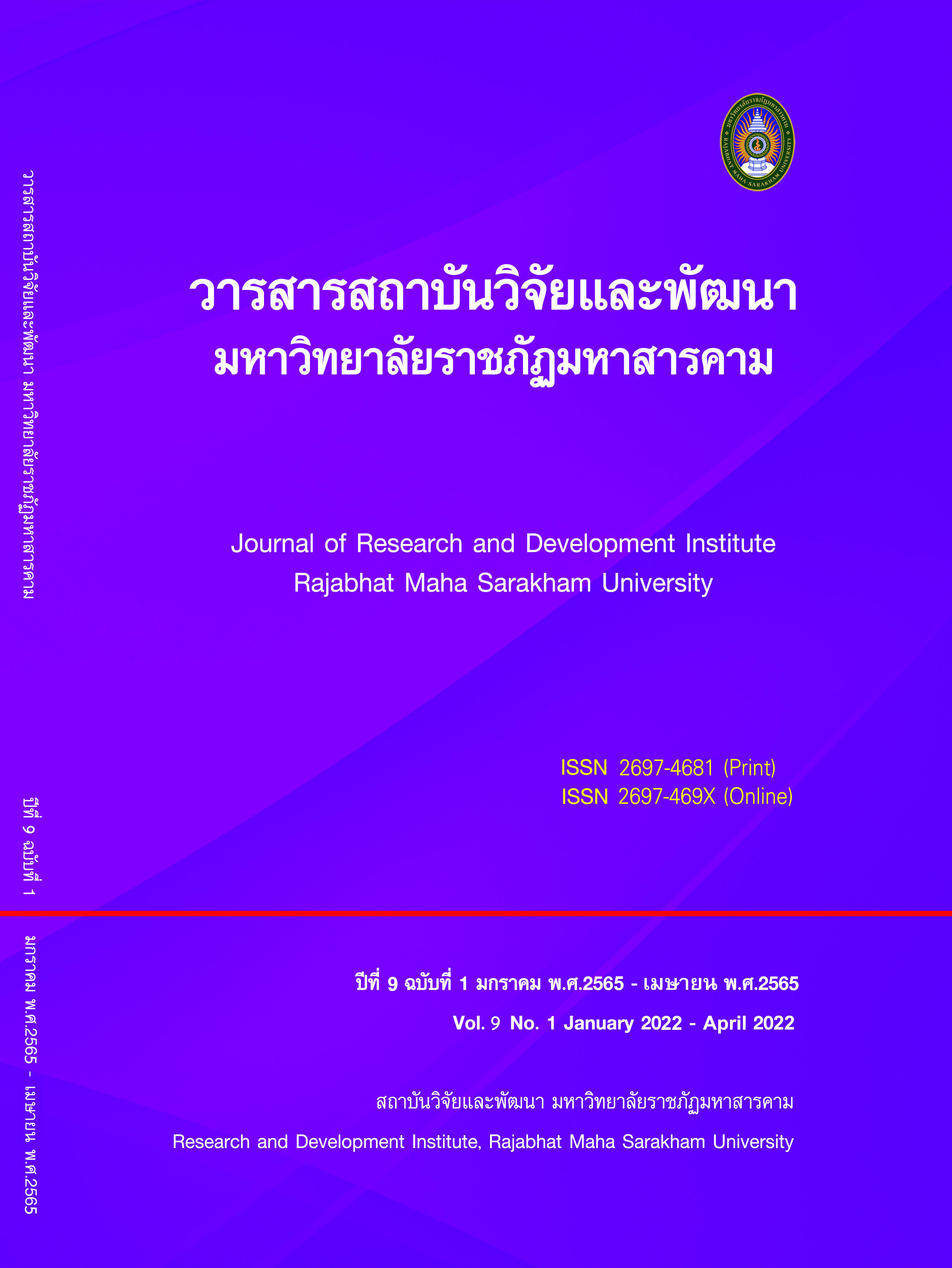The development of a threaded integrated instruction model to enhance information technology skill for Sports Science students Faculty of Education Rajabhat Maha Sarakham University
Keywords:
development model, threaded integrated, technology skillAbstract
This research aims to study was to thread integrated instruction model to enhance information technology skill for sports science student-faculty of education, Rajabhat Maha Sarakham University population and sample a student in the department of sports science faculty of education, Rajabhat Maha Sarakham University a total of 60 subjects were selected by purposive sampling. The statistics used in the research were mean standard deviation and the statistic that determined the level of statistical significance at the .05 level.The findings are as follows: 1. The level of satisfaction of the sample towards thread integrated instruction model to enhance information technology skill for sports science student-faculty of education, Rajabhat Maha Sarakham University the overall satisfaction level was 4.75±0.48 at the highest level. 2. Comparison of skills assessment results before and after studying thread integrated instruction model to enhance information technology skill for sports science student-faculty of education, Rajabhat Maha Sarakham University there are more post-learning skills than pre-learning skills. There was a statistically significant difference at the .05 level.
References
Blowers, S., Ramsey, P., Merriman, C., & Grooms, J. (2003). Patterns of peer tutoring in nursing. Journal of Nursing Education, 42(5), 204-210.
Candela, L., Kowalski, S., Cyrkiel, D., & Warner, D. (2004). Meeting the at-risk challenge: Empowering nursing students through mentoring. International Journal of Nursing Education Scholarship, 1-13.
Charlotte, W. (2010). Nursing and informatics for the twenty-first century: An International look at practice, education and EHR trends. American Medical Informatics Association.
Dewey, J. (1971). How We Think: A Restatement of the Relation of Reflective Thinking to the Educative Process. Addison-Wesley.
Dodge, L., & Kendall, M.E. (2004). Learning communities. College Teaching, 52(4), 150-155.
Edwards, J., & O’Connor, P.A. (July, 2011). Improving technological competency in nursing students: The passport project. The Journal of Educators, 8(2), 110-119.
Eley, R., Fallon, T., Soar, J., Buikstra, E., & Hegney, D. (2008). The status of training and education in information and computer technology of Australian nurses: A national survey. Journal of Clinical Nursing, 17(20), 2758-2767.
Fogarty, R. (1991). The mindful school: How to integrate the curricula. IRI/Sky Light Training and Publishing.
Ipa, B., Jones, S., & Jacobs, G. (May, 2007). Retention and application of information technology skills among nursing and midwifery students. Innovations in Education and Teaching International, 44(2), 199-210.
Jeerapat, W. (2011). Nursing informatics and health informatics. Bangkok: Chulalongkorn University.
Jeffreys, M.R. (2007). Nontraditional students’ perceptions of variables influencing retention: A multisite study. Nurse Educator, 32(4), 161-167.
Jesadawirot, S. (2003). Integrated teaching and learning management. Bangkok: Book Point.
Khamanee, T. (2012). Pedagogical Sciences: Knowledge for effective organization of learning processes. Bangkok: Chulalongkorn University.
Kitiphadung, K. (2008). Needs for Computing Competency Development of Social Studies Teachers at Bangkok Secondary Schools. Bangkok: Chulalongkorn University.
Lake, K. (2000). Integrated curriculum. [Online]: http://educationnorthwest.org/sites/Default/files/integrated-curriculum.pdf.
May 2021]
Levett-Jones, T., Kenny, R., Bourgeois, S., Hazelton, M., Kable, A., & Van Der Riett, P. (2009). Exploring the information and communication technology competence and confidence of nursing students. Nurse Education Today, 29(6), 612-616.
McCannon, M., & O’Neal, P. (2003). Results of a national survey indicating information technology skills needed by nurses at time of entry into the work force. Journal of Nursing Eduction, 42(8), 337-340.
McLaughlin, B.N. (2008). Retention issues: What can we do?. Teaching and Learning in Nursing, 3, 83-84.
McNamara, K. (2003). Information and communication technologies, poverty and development: Learning from experience. [Online]. http://www.infodev.org/en/Publication.17html. [4 May 2021]
McNeil, B.J., Elfrink, V.L., & Bickford, C.J. (2003). Nursing information technology knowledge, Skills, and preparation of student nurses, nursing faculty, and clinicians: A U.S. survey. Journal of Nursing Education, 42(8), 341-349.
Nguyen, D.N. (2011). A survey of nursing faculty needs for training in use of new technologies. Journal of Nursing Education, 50(4), 181-189.
Partnership for 21st Century. (2011). Our mission is to realize the power and promise of 21st century learning for every student—in early learning, in school, and beyond school—across the country and around the globe. [Online]. http://www.p21.org/storage/documents/P21-Framevwork-Definitions.pdf. [4 May 2021]
Pruksakulnan, W. (2009). Developing a model for improving personnel's capacity in information technology and communication. Office of the Permanent Secretary, Ministry of Education. Bangkok: Srinakharinwirot University.
Robshaw, M., & Smith, J. (2004). Keeping afloat: Student nurses’ experiences following assignment referral. Nurse Education Today, 24, 511-520.
Sayles, S., & Shelton, D. (2005). Student success strategies. ABNF Journal, 98-101.
Siriakbancha, C. (2016). Developing an integrated teaching and learning model with Threaded method to develop information technology skills of nursing students at private universities. Chonburi: Burapha University.
Sports Authority of Thailand. (2012). National Sports Development Plan No. 5 (2012-2016. Bangkok: Sports Authority of Thailand.
Staggers, N., Gassert, C., & Curran, C. (2002). A Delphi study to determine informatics competencies for nurses at four levels of practice. Nursing Research, 51(6), 383-390.
Tansakul, T. (2015). Life skills strategy for youth personality development. Bangkok: Office of the Narcotics Control Board.
Wongyai, W. (2001). New Curriculum Integration. Journal of San Patirup, 4(44), 50-53.
Downloads
Published
How to Cite
Issue
Section
License
Copyright (c) 2022 Journal of Research and Development Institute Rajabhat Maha Sarakham University

This work is licensed under a Creative Commons Attribution-NonCommercial-NoDerivatives 4.0 International License.
Articles that are published are copyrighted by the authors of the articles







